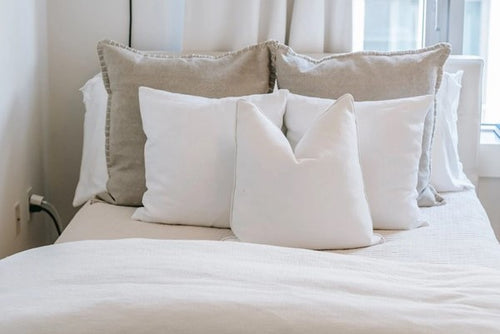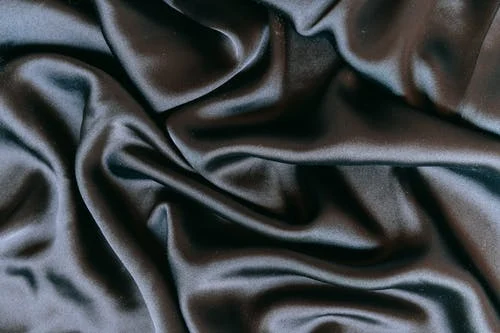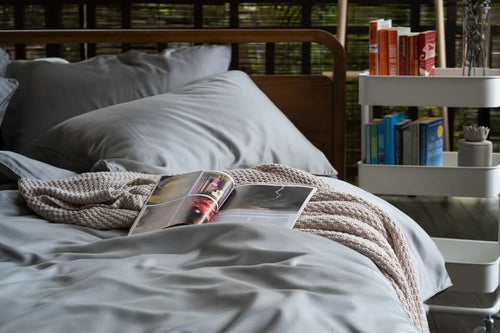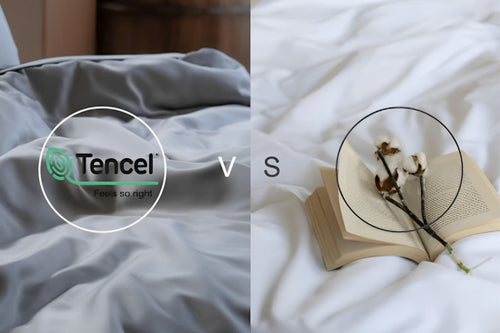At a Glance
As brands prioritise environmental sustainability, we look into eco-friendly bedsheets available. Which one should you choose?
Quick Tips
- Watch out for microplastic-containing materials.
- Look into certifications to ensure proper production guidelines have been adhered to.
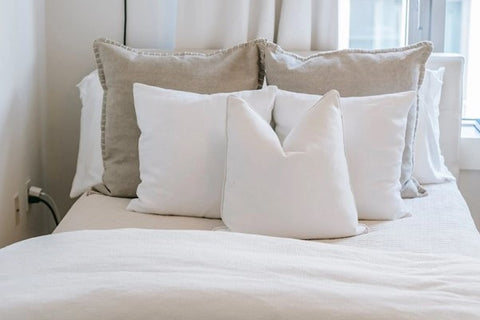
Image by Charlotte May from Pexels
Global warming has been a growing topic of concern over the past few years and with that, many are making the effort to choose sustainable and eco-friendly products when shopping. Sustainable products often have additional benefits that come hand in hand with them being environmentally friendly. These benefits include the products being manufactured with chemical-free processes that are non toxic, thus being highly beneficial when it comes to products in contact with your skin such as bed sheets.
With brands being increasingly environmentally conscious, there are plenty of eco-friendly bedding options in the market. That now leaves the question of which materials you should choose for an eco-friendly bed sheet.
Here is what you need to know about eco-friendly bed sheets before you buy them:

Image by Alena Koval from Pexels
What Makes Bedding Eco-Friendly?
To ensure that a bed sheet is truly eco-friendly, it starts from the manufacturing processes. In general, sustainable manufacturing processes use less water and do not utilize pesticides nor bleach. Moreover, they do not include harmful components such as microplastics, which also means that they can be recycled and are fully biodegradable.
Most synthetic bed sheets consist of plastic materials such as polyester, nylon, and acrylic, which contribute to ocean pollution during their production process. Furthermore, these microplastic-containing materials leak into the environment even after being cleaned and may wind up in drinking water and soil.

Image by cottonbro from Pexels
When selecting an eco-friendly bed sheet for yourself, you should keep a lookout for Global Organic Textile Standard, the OEKO-TEX Standard 100, and Fair Trade certifications to ensure that your bedding is truly environmentally friendly. These certifications ascertain that the proper production guidelines have been adhered to, such as materials being ethically sourced, organic, safe, and responsibly labeled. This is due to textiles being commonly subjected to extensive chemical testing, hence, firms are scrutinized throughout the agricultural and manufacturing processes.
Popular Sustainable Bedding Materials

Featuring Weavve’s TENCEL™ Lyocell Deluxe Set Bed Sheets in Sandshell
Organic Cotton bed sheets
Cotton is one of the most widely used fibers in today's textile industry, second only to polyester in terms of popularity. Cotton's resilience and breathability makes it one of the most extensively used fibers for bedding sheets. However ordinary non-organic cotton is associated with significant environmental issues. This is because non-organic cotton is one of the world's top three genetically modified crops, and it accounts for 16 percent of all pesticides, even though it occupies only 2.5 percent of the world's arable land.
Thus, despite being deemed a classic bed sheet material choice by many, environmentally conscious buyers should avoid non-organic cotton bed sheets due to the negative impact it has on the environment.
Properties: Organic cotton fibers are breathable and a good choice of material for hot sleepers. They are also easy to care for and durable which makes them an inexpensive bedding material option for eco-friendly shoppers.

Featuring Weavve’s TENCEL™ Lyocell Deluxe Set Bed Sheets in Sandshell
Pros and Cons of Organic Cotton bed sheets
Organic cotton differentiates itself from regular cotton through its cultivation and manufacturing process. They are free of pesticides, formaldehyde, and other dangerous substances, making them an ideal and safe choice for the making of bed sheets. Organic cotton is also incredibly soft, making them a popular material for bedding.
Eco-friendly organic cotton sheets are also usually dyed using natural procedures, or simply left undyed and unbleached, giving them a natural appearance.
On the downside of organic cotton sheets, they are prone to shrinkage after washes. Despite this, there are ways to avoid shrinkage by washing them using a cold, gentle cycle, and allowing them to air dry. In cases where it states that the sheets have been 'pre-shrunk,' this means that you may wash them on a warm water cycle without having to worry about them shrinking too much. Another soft alternative to organic cotton bed sheets would be TENCEL™ bed sheets, which are highly breathable and wrinkle resistant in comparison.

Featuring Weavve’s TENCEL™ Lyocell Deluxe Set Bed Sheets in Blush Pink
TENCEL™ bed sheets
You may or may not be familiar with the term TENCEL™, but you most likely heard about eucalyptus plants before. TENCEL™ fibers are also known as eucalyptus bed sheets as they derive primarily from the plant, and do not contain any plastic, petroleum, or petrochemicals in its construction. The manufacturing process of TENCEL™ fibers is accomplished by using a closed-loop method which recycles nearly all water and solvents used in the process. TENCEL™ fibers are semi-synthetic cellulosic fibers derived from sustainably harvested, fast-growing, and highly renewable eucalyptus trees. After the wood pulp is extracted, they are then converted into the fibers using a non-toxic solvent known as amine oxide.
Properties: TENCEL™ has an incredibly silky smooth cool hand feel and a lustrous finish. Despite its delicate appearance, TENCEL™ bed sheets are extremely durable and tear resistant. Additionally, TENCEL™ sheets are naturally antibacterial, antimicrobial and have excellent temperature regulating properties, which make them the best bed sheets for hot sleepers.

Featuring Weavve’s TENCEL™ Lyocell Deluxe Set Bed Sheets in Blush Pink
Pros and Cons of TENCEL™ bed sheets
TENCEL™ bed sheets not only look like silk bed sheets but feel like them too. In contrast to silk bedding which has some ethical concerns around harvesting silkworms in the manufacturing process, TENCEL™ bed sheets are both ethical and sustainable in their production. Furthermore, TENCEL™ sheets are shrink and wrinkle resistant with a drape quality to them, which gives them a luxurious appearance. TENCEL™ fibers are also moisture wicking and breathable, which is the reason behind their cool hand feel and makes them the ideal bedding material for hot climates such as Singapore.
On the other hand, TENCEL™ bed sheets are considered relatively pricey due to manufacturing and processing costs. Moreover, there are some TENCEL™ sheet sets that are not machine washable as it may damage them.
Linen bed sheets
Linen is derived from the flax plant, which requires little pesticides or fertilizers to thrive, and consumes far less water than organic cotton. When cultivating flax, little or no irrigation is needed and thus, seasonal rainfall suffices as its main source of water supply.

Featuring Weavve’s TENCEL™ Lyocell Classic Set Bed Sheets in White
Properties: Linen fabrics are highly breathable and have great temperature regulating properties. This makes linen bed sheets more airy than cotton bed sheets and suitable for all weather conditions and climates. In comparison to cotton, linen fabrics are slightly heavier in weight and it is both more durable and resistant to sun damage than cotton. While linen is not as soft as some other bedding fabrics upon first use, they can become increasingly soft with each wash.
In addition, due to their temperature regulating properties, linen bed sheets are a great sustainable bed sheet option for individuals who live in warm regions or who wish to utilize only one type of bedding throughout the year's temperature variations. Linen sheets can be on the pricier side, however, it can be considered an investment as they will last you for decades to come due to their great quality.

Image by cottonbro from Pexels
Pros and Cons of Flax Linen bed sheets
Linen is even more absorbent, breathable, and insulating than cotton, making it ideal for keeping you cool and dry in the summer, and comfortable and warm in the winter. Flax linen bed sheets are also hypoallergenic, promote regular sebaceous gland function, and can help you sweat less during sleep.
Furthermore, linen bed sheets are long-lasting and may be cultivated without pesticides, fertilizers, or other chemical input. Most of the time, flax will have been cultivated organically simply because it makes the most sense for farmers.
On the downside of linen sheets, they may be rough during initial use and are wrinkle prone. Moreover, they also do generally come at a higher price point which may not be ideal if you are on a budget.

Image by Toni Cuenca from Pexels
Bamboo bed sheets
Pure bamboo fiber bed sheets make a great choice for sustainable bedding as well. However, do keep in mind that oftentimes bamboo bed sheets are made of a blend including other fibers such as cotton or polyester, which would disqualify them as a sustainable bed sheet.
Properties: Bamboo bed sheets are naturally hypoallergenic and smooth to the touch, which would benefit those who have sensitive skin. On top of that, they are also breathable and do not retain excess moisture so you can sleep comfortably and stay fresh through the night.

Image by Pixabay from Pexels
Pros and Cons of Bamboo
Bamboo sheets are durable and relatively long lasting so you need not worry about having to replace them often. Furthermore, they are also soft and gentle upon first use which is an advantage they have over cotton bed sheets. In comparison to TENCEL™ bed sheets, bamboo bed sheets have similar moisture wicking abilities to help you sleep cool at night which would be beneficial to hot sleepers.
However, although the bamboo plant is rather sustainable, bamboo sheets may sometimes not be as eco-friendly as you think. This is due to their manufacturing process typically involving heavy chemical usage which may simply offset the eco-friendliness of bamboo plants at the end of the day. With that being said, not all bamboo sheets are made the same and there are companies that do produce them sustainably. The best way to identify this is to look for certifications verifying their processes. Another aspect that might be a downside to some would be that bamboo sheets are highly wrinkle prone and may not be as flattering in appearance without ironing.
Weavve TENCEL™ Lyocell sheets

Featuring Weavve’s TENCEL™ Lyocell Fitted Set Bed Sheets in Mist Gray
Each Weavve TENCEL™ Lyocell bedding starts with the best lyocell fibers (100% Lenzing TENCEL™) with no blend that are spun into the finest 80s yarn count threads. These fine single ply threads are then woven into 400 thread count fabric, giving you stronger, smoother and lighter sheets.
Shop TENCEL™ Lyocell sheets Singapore
Weavve Cotton Sateen sheets

Featuring Weavve’s TENCEL™ Lyocell Classic Set Bed Sheets in Sandshell
The Weavve Cotton sheet starts with extra-long staple cotton fibers. Fewer extra-long staple fibers are required to spin the same length of yarn. As Weavve’s threads are finer (100 yarn count), we’re able to squeeze more together, resulting in a high thread count. We’re also using single ply threads, giving you stronger, smoother and lighter sheets.
Our cotton sateen linen uses a four over and one under weave pattern as well as processes like singeing and calendering to give our sateen sheets a luxurious sheen and smooth feel. Pre shrinking also prevents our sheets from shrinking during regular washing.
Shop our full range of bed sheets here































